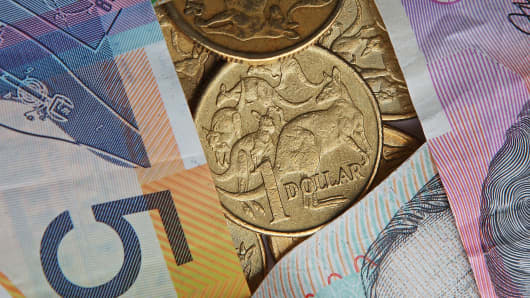The Australian dollar continued its dramatic slide on Thursday, hitting a 20-month low against the U.S. dollar below the 95 cent mark to levels unseen since October 2011.
The commodity currency has already given up more than 3 percent of its value this week alone and is down over 8 percent since May against a broadly firm U.S. dollar. Prospects for further rate cuts in Australia and weakness in commodity prices have added to the Aussie dollar's woes.
Finding no consolation from data on Wednesday that showed Australian exports to China in May hit a record high, the dumping of the Aussie dollar prompted such tweets from strategists.
"AUD/USD (Australian dollar/U.S. dollar) has now lost 10.6 percent in the last 40 trading sessions. In equity land that would be a correction, in FX that is a massacre," Chris Weston, chief market strategist at trading firm IG, tweeted.
Weston told CNBC that all signs point to further falls in the currency, which he predicts will slump to at least 90 U.S. cents this year, maybe more at the current trajectory. And that implies a fall of a further 5 percent from current levels.
"It's [Australian dollar] had a big fall already, a lot of bad news has been priced in, but I think it's got a lot further to go," Weston said. "If you look at the pace and veracity of the selling at the moment, further down the line, it's going to get much weaker."
(Read More:
Why Shorting the Aussie Is 'Trade of the Century'
)
Hans Goetti, chief investment officer at wealth management firm Finaport backed that sentiment, saying risks like further interest rate cuts in Australia, and the prospect of a slowdown in China are leading to the Aussie lose its allure.
"If you're a chartist you will see that there has been a multi-year top formed and the Aussie is on the verge of breaking down and if that happens there's very little support to about 85 or so," Goetti said.
Australian economic data on Wednesday showing weaker-than-expected annual gross domestic product (GDP) growth of 2.5 percent in the first quarter has reinforced expectations that the Reserve Bank of Australia will cut interest rates at its next meeting. The RBA last cut rates in early May.
(Read More: The Aussie Dollar Just Can't Catch a Break )
"Parts of Australia are now in a technical recession, the domestic economy here is in a really bad state – domestic demand is very weak," Weston said. "They're going to have to bring rates down, they're going to have to bring the currency down as well – I think we're likely to see the start of the falls."
A stronger U.S. dollar is also playing a big role in the downtrend of the Aussie, according to Weston, who said talk of the U.S. Federal Reserve tapering its quantitative easing means investors will be bullish on the U.S. dollar in the longer term.
"People have said to themselves I want to express my U.S. dollar strength against something -- you know it's been the Australian dollar and some of the emerging market currencies that have been the preferred way of expressing their bearishness," Weston said.
(Read More:
Wild Swings? Emerging Currencies Have It the Worst
)
— By CNBC.com's Rajeshni Naidu-Ghelani. Follow her on Twitter @RajeshniNaidu


